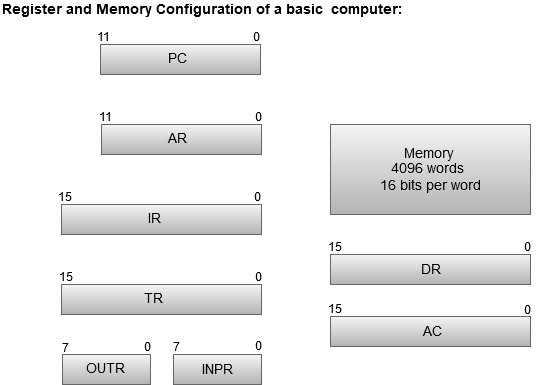How Distinguish How Many Registers
side by side → ← prev
Figurer Registers
Registers are a type of computer retentiveness used to quickly accept, store, and transfer data and instructions that are existence used immediately past the CPU. The registers used by the CPU are often termed as Processor registers.
A processor register may hold an pedagogy, a storage address, or any data (such as bit sequence or individual characters).
The computer needs processor registers for manipulating information and a register for property a memory address. The register property the memory location is used to summate the accost of the next instruction subsequently the execution of the current instruction is completed.
Following is the list of some of the near mutual registers used in a basic computer:
| Register | Symbol | Number of bits | Office |
|---|---|---|---|
| Data register | DR | sixteen | Holds retentiveness operand |
| Address register | AR | 12 | Holds address for the memory |
| Accumulator | AC | 16 | Processor register |
| Educational activity annals | IR | 16 | Holds educational activity code |
| Program counter | PC | 12 | Holds address of the instruction |
| Temporary register | TR | xvi | Holds temporary information |
| Input register | INPR | viii | Carries input character |
| Output register | OUTR | viii | Carries output character |
The following prototype shows the register and memory configuration for a basic computer.

- The Memory unit has a capacity of 4096 words, and each word contains xvi $.25.
- The Data Register (DR) contains 16 bits which hold the operand read from the memory location.
- The Retentiveness Accost Annals (MAR) contains 12 bits which hold the address for the memory location.
- The Program Counter (PC) as well contains 12 bits which concord the address of the next education to be read from retention subsequently the current instruction is executed.
- The Accumulator (AC) register is a general purpose processing register.
- The teaching read from memory is placed in the Instruction register (IR).
- The Temporary Register (TR) is used for holding the temporary data during the processing.
- The Input Registers (IR) holds the input characters given by the user.
- The Output Registers (OR) holds the output after processing the input data.
Next Topic COA Tutorial
← prev next →
 For Videos Join Our Youtube Aqueduct: Bring together Now
For Videos Join Our Youtube Aqueduct: Bring together Now
Feedback
- Transport your Feedback to [e-mail protected]
Assist Others, Please Share



How Distinguish How Many Registers,
Source: https://www.javatpoint.com/computer-registers
Posted by: marrowabeatice.blogspot.com


0 Response to "How Distinguish How Many Registers"
Post a Comment